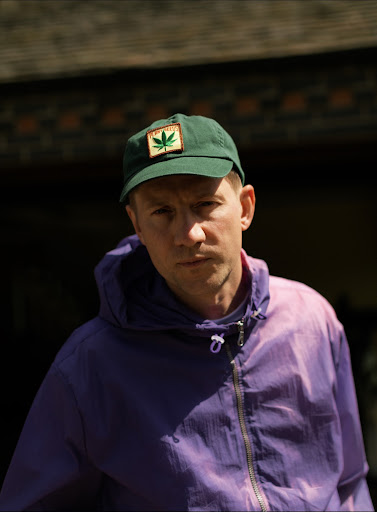The Producer’s Voice: Riton [@Ritontime]
![The Producer’s Voice: Riton [@Ritontime]](https://guap.co/wp-content/uploads/2021/09/205032560_351474853003769_5909376466592401590_n.v1-e1630938335534-180x180.jpg)
Words By Miki Hellerbach
The Producer’s Voice is a new series for GUAP where we highlight the stories of instrumental crafters. We hope to bring their stories to the forefront instead of kept behind the artist they are producing for.
Newcastle bred producer Riton is a scientist in the studio.
Riton‘s collection of equipment that surrounds him as we speak is directly referenced in explanation just as much as he talks about his life story. That said, his life story and how it pertains is wildly intriguing.
It all started around age 13 when Riton would ride around with mates in his older brother’s car, smoking weed, and listening to rave tapes. His older brother’s older friend would play the tapes and talk about the raves he attended which would fill Riton’s mind with wonder. He also remembers feeling quite influenced by Top of the Pops in the early 90s when the first acid house artists broke into the pop lane. He says “Pump Up The Volume” by Marrs was the first record he wanted to go and buy. He would see people playing 101 keytar synthesizers on songs like Deee-lite‘s “Groove Is In The Heart” and be motivated to get more engrossed in everything that was used to create all these tones.
After his parents finally started to let him go to raves he was hooked. He would go explore all of the sounds he heard and take his curiosity to record shops where he would buy records to listen to on his own. Still, in high school, all the guys who used to hang out in the stores liked the young Riton’s enthusiasm. When he expressed he wanted to make music they helped him get a sampler and Atari music software. Riton the producer was born.
After music college, Riton would start his own mini label called Switch Recordings. He and his mate found a place in Reading, a five-hour drive from Newcastle, which did drum and bass vinyl distribution and offered him a pressing distribution deal for putting out 12 inch vinyls. He put out a few releases and was then signed to a bigger label, Grand Central from Manchester. Riton would put out two albums and a few singles on that new label while working in a prominent record store and Djing during the evenings. When he was 20 he was even nominated locally as runner up to DJ of the year by a local publication. This would eventually lead to the birth of his next stage in London where he became known as a full-time DJ and remixer.
During this time as he bought more gear for work, Riton would produce for himself more and more. All of these many devices he keeps with him and uses to this day. He would eventually through that London DJ scene meet friends like Mark Ronson and countless others. Entrance into this sphere of producers would lead to Riton collaborating on as well as making his own records that would get recognition by the masses and even the Grammys, twice.

I asked Riton to give the backstory of three of his top instrumentals. Take a read.
“Electricity” by Silk City & Dua Lipa feat. Mark Ronson & Diplo
“”Electricity” was a collaborative effort. When I worked on it I was just adding the best I could cuz it was already a solid song. The foundation was great and it’s my favourite thing to do, getting something and using all this analog gear on it around me [points to gear surrounding him in his home studio]. I re-did everything through these vintage keyboards and drum machines to make everything better. The work to improve something is really fun and it’s also probably what I’m best at doing.
We did a tiny bit of arrangement changing but basically, I went through the drums and did different bits on the 909 and the 808. Then everything I tracked in through a Silent Hills preamp. Then I went onto my Chandler distresser and into the Culture Vulture [Thermionic]. Then EQed in the Lunch Box [module] last and after it went through I was so confident about the sound because it felt good. It had a lot of movement to it. I like that feel of it all coming from the machines, I don’t really use the plug-ins at all. Anything I can do externally, like even tides and loads to flangers, I’ll take the time to do it.
The bassline sound for “Electricity” was one sound put through Stereo (audio mixer). Then I stuck a mood underneath it for sub and used some sample stuff for attack. Then I grouped that and put it through an SSL Mixer and brought it up on a Stereo Fader. Then I blended in more compression on the master through the Culture Vulture again and used widening effects on Eventide [voice recording systems]. Then I mixed it and brought it in. So I basically did all you could’ve done by just turning on Serum [synthesizer]. But everything did need a bit of wetness on it and there’s something about doing it through that process that just sounds so good. The most satisfying bit was bouncing it down group by group.”
“Rinse & Repeat” by Riton & Kah-Lo
“Even though I didn’t win the Grammy, the nomination was gratifying to me because it was a track I didn’t compromise anything about. No one asked me to change one thing. It was the biggest played radio single in the UK that year as well. That was brilliant. That one was me taking everything I learned from DJing, then making a song that connected to people, but still trying to make it feel underground and unlike anything you’ve heard before.
Basically, Kah-Lo got in touch with me on Twitter saying she liked my stuff. I listened to her stuff and thought it was really cool. We both lived in New York at the time so she came to the studio. I had this slower beat that was about 105 bpm and was a Gesaffelstein sort of thing. I was really into French electronic music at the time.
Kah-Lo came in and rapped on it, but at first did it in a sort of American accent. She’s from Lagos but went to an American school. But when her sister called her up she spoke in Nigerian pidgin English with a sort of Nigerian patter. I was like, “Why don’t you do it a bit more like that?” She said, “I never really try and sing like that,” but I was like, “it’ll sound much cooler.” So she gave it a try and thought it was weird but it was really good. She recorded it on a shitty SM 757 mic and then she left.
I thought it was good but wanted to speed up the beat. Then I thought, “It would be cool to do a song with just one note in it,” and that’s what it’s got in the bassline. I’ve always been fascinated by that in techno. I also pulled up the tempo and made it more house-y then made that one note really fat.
I did all the sounds on the Prophet [synthesizer software] from about 8 years ago, the one that people don’t really like. It’s got these ring modulator effects. I made weird noises on the keyboard for ages and added them in using one that was pitched down two octaves. Then layered that up with a tom and subby bass. Then lined everything up in Ableton to make a hard and good sound finishing the body of it. Then there’s also these weird little background noises not doing any particular notes.
The drums were very simple house drums with hi-hats to pick them up here and there. Then what really makes it good is that really tweaky acid noise in the background which is just a chopped up Prophet sound. I fed that out separately left and right through an MSR flanger. It has a sort of feedback so it’s always changing.”
“Daffodils” by Mark Ronson feat. Kevin Parker
“The part I added to Mark’s song was drawn from the Steve Miller Band song “Macho City“. It’s a 15 minute song from a b-side. It’s very funky like Mark’s track was when he played it for me. He wanted me to do a cool synth part which I said I would do but said I also wanted to do something with the arrangement like “Macho City” and I played it for him. I wanted to take the kick drums out and have a live drummer. It was a lot of fun to do. I recorded it using all of my old modular stuff. I used a Roland System 100 with a full oscillator and an SQ 10 core sequencer. I jammed some crazy synth parts then suggested ideas for the end. We let it breathe and groove like an old band in the studio would when they smoked too much weed. We made it go weird then let it come back to the groove.”




![ZINO VINCI’S ‘FILTHY & DISGUSTING’EP BRINGS YOU TO THE CORE OF THE ARTIST [@ZinoVinci]](https://guap.co/wp-content/uploads/2023/10/Zino-4.jpg)




